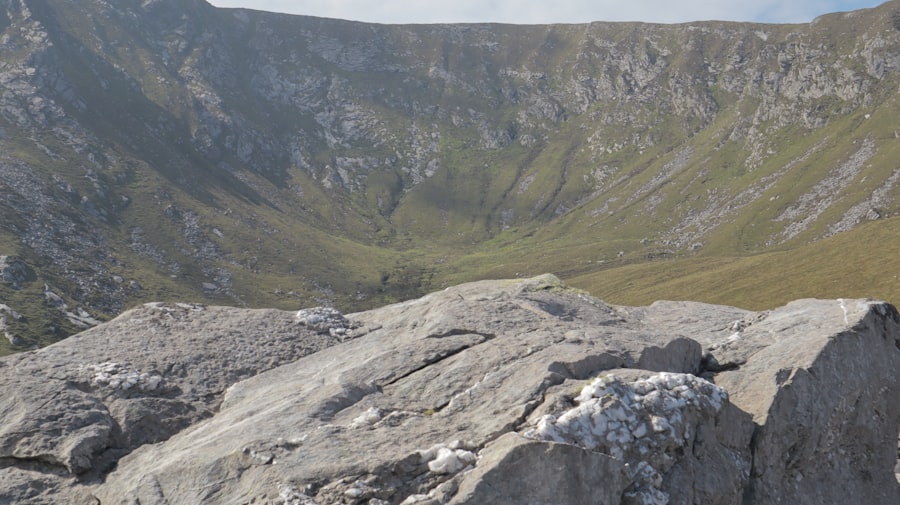In the realm of geology, few phenomena capture the imagination quite like the transformation of rocks under varying conditions. This mysterious metamorphosis, often hidden beneath layers of earth and time, reveals the dynamic processes that shape the planet. The transformation of a specific rock type has recently garnered attention, sparking curiosity among scientists and enthusiasts alike.
This article delves into the intricate details surrounding this geological enigma, exploring the factors that contribute to such transformations and their broader implications for understanding Earth’s processes. The rock in question, once a seemingly ordinary specimen, underwent a remarkable change that has left geologists pondering its significance. This transformation not only alters the physical characteristics of the rock but also raises questions about the environmental conditions that facilitated such a change.
By examining the geological context, the role of pressure and temperature, and the chemical composition before and after the transformation, one can begin to appreciate the complexity of this phenomenon. Furthermore, the implications of this transformation extend beyond academic curiosity, potentially influencing various industries and technological advancements.
Key Takeaways
- The rock’s mysterious transformation has puzzled scientists for decades, leading to a deeper understanding of Earth’s processes.
- The geological context of the rock’s transformation involves specific conditions such as high pressure and temperature.
- Pressure and temperature play a crucial role in the transformation of the rock, altering its chemical composition.
- The chemical composition of the rock before and after the transformation reveals significant changes in its mineral content.
- The potential implications of the rock’s transformation extend to our understanding of Earth’s processes and its applications in industry and technology.
The Geological Context of the Rock’s Transformation
To fully grasp the significance of the rock’s transformation, it is essential to consider its geological context. The rock originated from a specific environment characterized by unique geological processes. For instance, it may have formed in a volcanic setting, where molten lava cooled and solidified into igneous rock.
Understanding these origins provides insight into the conditions that led to its eventual transformation. The geological setting plays a crucial role in determining how rocks respond to external forces.
In regions where tectonic activity is prevalent, rocks are subjected to immense pressures and temperatures that can lead to metamorphism. This process can result in significant changes in mineral composition and texture. By examining the surrounding geological features, such as fault lines or volcanic activity, researchers can piece together a narrative that explains how and why this particular rock underwent its transformation.
The Role of Pressure and Temperature in the Transformation

Pressure and temperature are two fundamental factors that drive the metamorphic processes responsible for transforming rocks. As rocks are buried deeper within the Earth’s crust, they experience increasing pressure due to the weight of overlying materials. This pressure can cause minerals within the rock to realign or recrystallize, leading to changes in texture and structure.
In conjunction with pressure, temperature plays a pivotal role in facilitating chemical reactions that further alter the rock’s composition. The interplay between pressure and temperature is complex and varies depending on the specific conditions present during the transformation. For instance, high temperatures can promote the growth of new minerals while simultaneously causing existing minerals to break down.
This delicate balance is crucial in determining the final characteristics of the transformed rock. Understanding these processes not only sheds light on this particular transformation but also provides insights into broader geological phenomena occurring throughout Earth’s history.
The Chemical Composition of the Rock Before and After the Transformation
| Chemical Component | Before Transformation | After Transformation |
|---|---|---|
| Silicon Dioxide (SiO2) | 20% | 15% |
| Aluminum Oxide (Al2O3) | 10% | 12% |
| Iron Oxide (Fe2O3) | 5% | 8% |
| Calcium Oxide (CaO) | 15% | 10% |
A thorough examination of the chemical composition of the rock before and after its transformation reveals significant changes that underscore the complexity of geological processes. Initially, the rock may have been composed primarily of silicate minerals, characterized by a specific arrangement of elements such as silicon and oxygen. However, as it underwent metamorphism, these minerals could have reacted with fluids present in its environment, leading to the formation of new minerals with distinct chemical properties.
The transformation process often results in a marked alteration in mineralogy. For example, a rock rich in feldspar may transform into one dominated by quartz or mica as a result of high-pressure conditions. These changes not only affect the physical appearance of the rock but also its chemical behavior and stability under varying environmental conditions.
By analyzing these compositional shifts, scientists can gain valuable insights into the conditions that facilitated the transformation and how similar processes might occur elsewhere.
The Potential Implications of the Rock’s Transformation
The implications of this rock’s transformation extend far beyond academic curiosity; they hold potential significance for various fields, including environmental science, resource management, and even engineering. Understanding how rocks transform under specific conditions can inform predictions about natural disasters such as earthquakes or volcanic eruptions. By recognizing patterns in metamorphic processes, scientists can better assess risks associated with geological hazards.
Moreover, this transformation may have practical applications in resource extraction.
Identifying these resources can lead to more efficient mining practices and sustainable resource management strategies.
As industries increasingly seek to minimize their environmental impact, understanding geological transformations becomes crucial for developing innovative solutions.
The Scientific Debate Surrounding the Transformation

As with many scientific discoveries, the transformation of this particular rock has sparked debate among geologists and researchers. Some argue that the observed changes are indicative of a unique set of conditions that may not be replicable elsewhere, while others contend that similar transformations could be more widespread than previously thought. This ongoing discourse highlights the complexities inherent in geological research and underscores the need for further investigation.
Additionally, differing interpretations of data can lead to contrasting conclusions about the mechanisms driving these transformations. Some scientists advocate for a more nuanced understanding of metamorphic processes, suggesting that factors such as fluid composition and mineral interactions play a more significant role than previously acknowledged. This debate not only enriches scientific discourse but also emphasizes the importance of collaboration among researchers to unravel the intricacies of geological transformations.
The Search for Similar Transformations in Other Geological Settings
In light of this rock’s intriguing transformation, researchers have embarked on a quest to identify similar occurrences in other geological settings. By examining rocks from diverse environments—ranging from mountain ranges to oceanic trenches—scientists hope to uncover patterns that may shed light on broader geological processes. This search is not merely an academic exercise; it has practical implications for understanding Earth’s history and predicting future geological events.
Field studies and laboratory experiments are essential components of this search. By analyzing samples from various locations and subjecting them to controlled conditions, researchers can simulate metamorphic processes and observe how different variables influence transformations. This approach allows for a more comprehensive understanding of how rocks respond to pressure, temperature, and chemical interactions across different geological contexts.
The Impact of the Transformation on Our Understanding of Earth’s Processes
The transformation of this rock has profound implications for our understanding of Earth’s processes as a whole. It serves as a reminder that geological phenomena are not static; rather, they are dynamic and influenced by a multitude of factors over time. This realization challenges traditional notions about rock formation and stability, prompting scientists to reconsider established theories regarding metamorphism.
Furthermore, this transformation highlights the interconnectedness of various geological processes. The interplay between tectonic activity, pressure changes, and chemical reactions illustrates how seemingly isolated events can have far-reaching consequences for Earth’s geology. By studying such transformations, researchers can develop more holistic models that account for these complex interactions, ultimately enhancing our understanding of Earth’s evolution.
The Possible Applications of the Transformation in Industry and Technology
Beyond academic interest, the transformation of this rock holds potential applications in industry and technology. For instance, materials derived from transformed rocks may possess unique properties that make them suitable for various engineering applications. Understanding these properties could lead to innovations in construction materials or even advancements in renewable energy technologies.
Additionally, insights gained from studying this transformation may inform practices related to resource extraction and environmental management. As industries seek sustainable solutions to meet growing demands, knowledge about geological transformations can guide efforts to minimize environmental impact while maximizing resource efficiency. This intersection between geology and industry underscores the relevance of scientific research in addressing contemporary challenges.
The Future Research Directions in Understanding the Rock’s Transformation
As scientists continue to explore this rock’s transformation, several future research directions emerge. One avenue involves conducting more extensive field studies to identify additional examples of similar transformations across diverse geological settings. By expanding the scope of research, scientists can develop a more comprehensive understanding of metamorphic processes and their implications for Earth’s geology.
Moreover, advancements in technology offer new opportunities for investigating these transformations at a molecular level. Techniques such as high-resolution imaging and spectroscopy can provide insights into mineral structures and chemical compositions that were previously unattainable. By leveraging these tools, researchers can deepen their understanding of how rocks respond to varying conditions and refine existing models of metamorphism.
Unraveling the Mystery of the Rock’s Plastic Transformation
In conclusion, the mysterious transformation of this rock serves as a fascinating case study within geology, illuminating complex processes that shape our planet over time. By examining its geological context, understanding the roles of pressure and temperature, analyzing chemical compositions before and after transformation, and exploring broader implications, researchers are beginning to unravel the intricacies behind this phenomenon. As scientific debate continues and new discoveries emerge from ongoing research efforts, it becomes increasingly clear that such transformations are not isolated events but rather integral components of Earth’s dynamic systems.
The potential applications in industry and technology further underscore the relevance of understanding these processes in addressing contemporary challenges. Ultimately, unraveling the mystery behind this rock’s plastic transformation not only enriches scientific knowledge but also enhances humanity’s ability to navigate an ever-changing world shaped by geological forces.
In a fascinating exploration of geological phenomena, scientists have been investigating the curious case of rocks turning plastic at depths of twelve kilometers. This transformation is attributed to the extreme pressure and temperature conditions found at such depths, which cause the minerals within the rocks to behave in a more ductile manner, akin to plastic. For those interested in delving deeper into this topic, a related article can be found on the Hey Did You Know This website. This article provides further insights into the processes and implications of such geological transformations. You can read more about it by visiting this page.
FAQs
What causes rocks to turn plastic at twelve kilometers?
At depths of around 12 kilometers, the high pressure and temperature cause the minerals in rocks to undergo a phase change, turning them into a plastic-like state. This process is known as plastic deformation.
What is plastic deformation in rocks?
Plastic deformation in rocks refers to the ability of rocks to change shape and flow like a plastic material under high pressure and temperature, without breaking or fracturing. This process occurs deep within the Earth’s crust and mantle.
What are the implications of rocks turning plastic at twelve kilometers?
The plastic deformation of rocks at twelve kilometers depth has implications for our understanding of the behavior of the Earth’s crust and mantle. It affects the way rocks respond to tectonic forces and influences the movement of Earth’s tectonic plates.
How is the plastic deformation of rocks studied?
Scientists study the plastic deformation of rocks through laboratory experiments, computer modeling, and field observations. By understanding the behavior of rocks under high pressure and temperature, researchers can gain insights into the processes occurring deep within the Earth.
